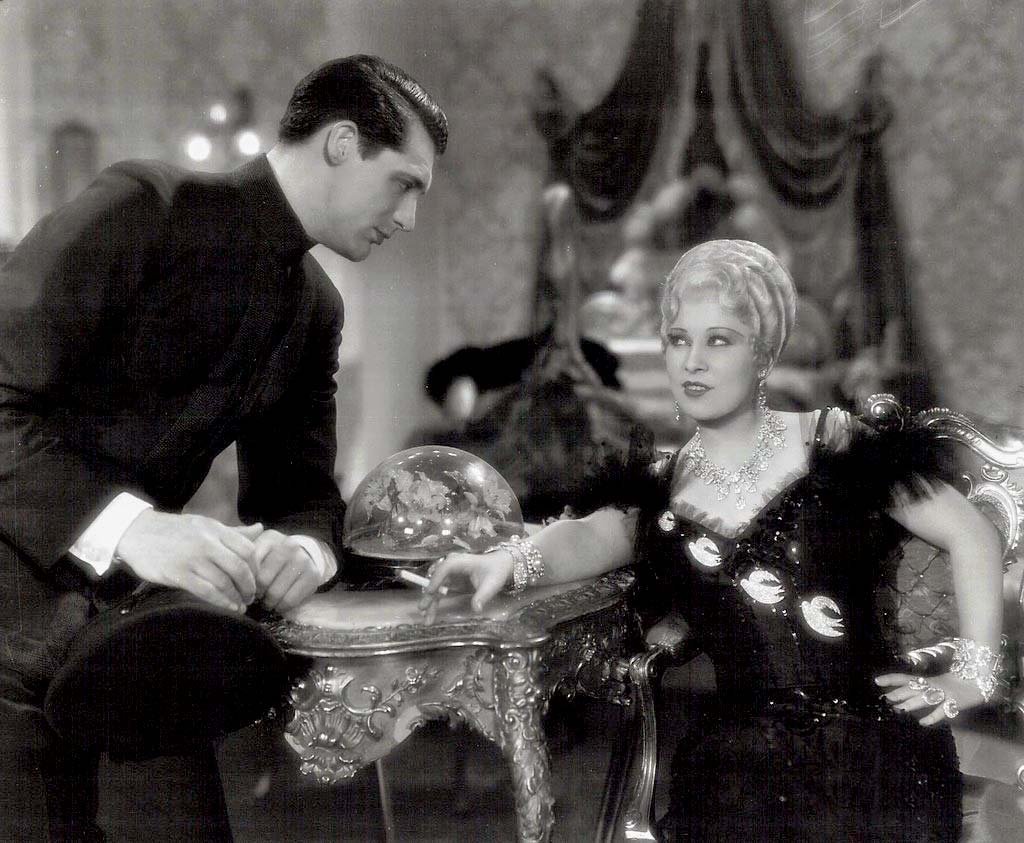Playing Her Script Their Way: A Reconsideration of Mae West (Preview)
Reviewed by J. E. Smyth
Do you remember Barbara Stanwyck in that early ocean liner dining room scene in The Lady Eve (1941), as she surveys the other guests through her compact mirror? In that classic Preston Sturges comedy, she portrayed Jean Harrington, a sleek grifter fishing for rich suckers who want to beat her and her father “Colonel” Harry Harrington (Charles Coburn) at cards. Most of the other women in the room are trying to hook millionaire Charles Pike (Henry Fonda). Some ogle, some flutter their eyelashes, some lean so low over their tables their décolletage all but flops into their soup. One substantial dame saunters by and even drops a handkerchief in hopes that her wealthy mark will gallantly pick it up for her. But cold-fish Fonda won’t take the bait, so she bends over to retrieve it, the seams of her dress won’t take it, and… Well, you get the picture.
A few seconds later, Stanwyck salutes one technically blonde girl as she sashays by Fonda with an extra swing in her hips, “Here comes the lady champion wrestler…” If you haven’t been giggling at the commentary yet, this should send you over the edge. Then, of course, Stanwyck’s Jean has a foolproof way to deal with the rich guy who is immune to her charms—she trips him and literally picks him up. The rest is history.
Cary Grant and Mae West in She Done Him Wrong.
But, on reflection, so is Mae West—for she’s the ghost in the room, the woman who taught all those other broads how to make an impression on a guy. None of them have West’s beauty or strategically placed assets or any dialogue, but they know the moves and make the most of them—to no avail. Mae West’s brand of charm may always have been over the top, a parody of lush female sexuality, but by 1941, and facing Ms. Stanwyck, she had definitely been upstaged and consigned to the past. Mae West had gone out of style.
That was rough, particularly coming from a Paramount production. Back in the early 1930s, it was West’s films that saved the studio from going under during the Great Depression. They regularly made ten times their production cost in their first run in theaters. Only Shirley Temple ever came close to West’s box office popularity in that era. As the star grumbled during one interview, “They oughta have a statue of me,” or, she added, leaving the irony to the rest of us, “At least a bust.”
West with George Raft in her debut, Night After Night, in which Raft observed, “She stole everything but the cameras.”
Although female filmgoers probably had to drag their boyfriends to Temple films or those fizzy Ginger Rogers confections or the “women’s films” of drama queens Greta Garbo and Bette Davis, men didn’t need much persuading to attend Mae West’s fare. As her most famous screen creation Lady Lou says in She Done Him Wrong (1933), “When women go bad, men go right after them.” West’s range of platinum bad girls did the trick at the box office. As the star laughed, “Men were always most of my audience.”
There were a lot of blondes to choose from in 1930s Hollywood. For zany wit, cinemagoers had Carole Lombard. For extreme glamour, there was Constance Bennett. If they wanted something exotic, they paid for Marlene Dietrich. For the best in homegrown sex appeal—well, there was only ever and will only ever be Jean Harlow, who, according to critic Graham Greene, “totes a breast the way a man totes a gun.” Then, of course, there was Mae West. And to extend Greene’s metaphor, if Harlow was an efficient 38-caliber revolver in Hollywood’s sexual arsenal, Mae West was the heavy artillery. She was the whole show, the woman who took no prisoners, who, as co-star and friend George Raft remembered, “stole everything but the cameras” in her first film role in Night After Night (1932). She was the era’s sex gangster…
To read the complete review, click here so that you may order either a subscription to begin with our Fall 2021 issue, or order a copy of this issue.
Copyright © 2021 by Cineaste Magazine
Cineaste, Vol. XLVII, No. 1


